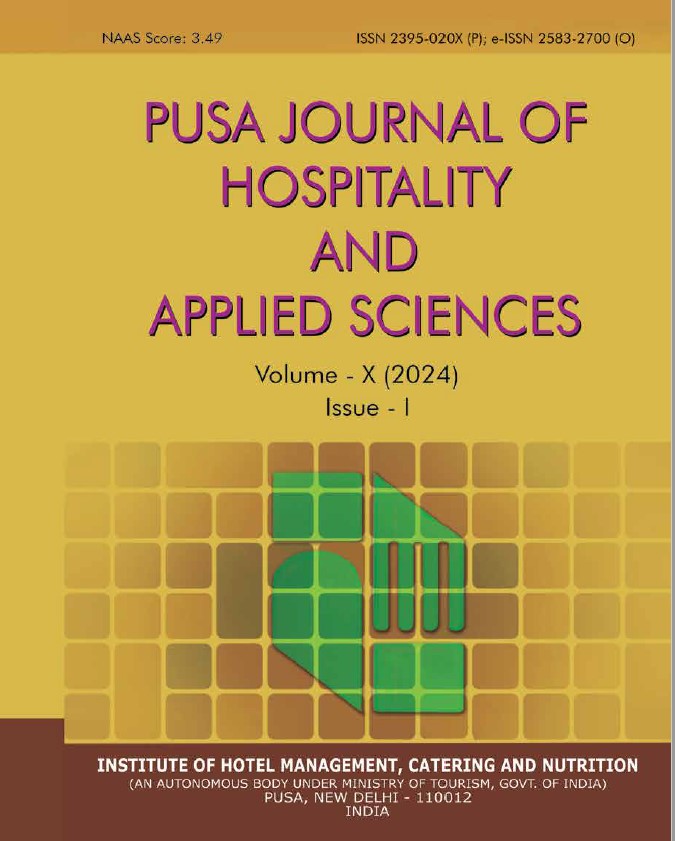Intention to Visit Uttarakhand among Potential Young Indian Travelers: Travel Motivations, Perceived Risks and Constraints
DOI:
https://doi.org/10.48165/pjhas.2024.10.2.2Keywords:
Uttarakhand, young travellers, travel motivation, perceived travel risks, travel constraints, tourism, responsible tourismAbstract
Background: Uttarakhand, often called the "Land of Gods," is renowned for its breathtaking landscapes, spiritual heritage, and adventure opportunities. Despite its potential, young Indian travellers aged 18–25 face diverse motivations and deterrents that shape their travel decisions. Understanding these factors is vital for enhancing Uttarakhand’s appeal among this demographic. Objectives: The primary objective of this study is to investigate the travel intentions of young Indian travelers by examining the factors that motivate them to visit Uttarakhand, alongside the perceived risks and constraints that deter them. Methodology: A survey-based descriptive research design was adopted, collecting data from 100 respondents at a hospitality institute in Delhi through structured questionnaires using Google Forms via one-on-one interactions. Statistical tools, including frequency distribution and Chi-Square analysis, were employed to examine relationships between variables. Results: The findings indicate that natural beauty (38%) and adventure experiences (25%) are the top motivators for travel, while religious motivations are less influential. The relationship between variables: such as gender, travel motivations (χ² = 3.84, p = 0.43), seasonal preferences (χ² = 12.51, p = 0.70), and perceived risks (χ² = 12.15, p = 0.016). There is no significant relationship between gender and primary travel motivations (p > 0.05), nor between travel motivations and preferred seasons (p > 0.05). However, natural disasters emerged as a significant perceived risk (p < 0.05), deterring travel and increasing the preference for sustainable tourism. Time and budget constraints significantly shape transportation preferences, favoring buses and personal vehicles. Short stays (<10 days) and proximity to attractions dominate traveler choices. Conclusion: Uttarakhand is highly appealing to young travelers but requires improved safety measures, infrastructure, and eco-friendly tourism strategies. Addressing these concerns is crucial for enhancing the state’s appeal and ensuring sustainable tourism development.
References
Ahmed, N., & Rajouri, G. P. G. C. (2013). Sustainable tourism development in Uttarakhand region of India. International Journal of Management and Social Sciences Research, 2(4), 106-111.
Akihito, N. (2017). Development of tourism and the tourist industry in India: A case study of Uttarakhand. Journal of Urban and Regional Studies on Contemporary India, 3(2), 1-12.
Bansal, S. P., & Gangotia, A. (2010). Perception of tourist: A case study of Uttarakhand. International Journal of Hospitality & Tourism Systems, 3(1).
Kala, D. (2021). ‘Thank you, God. You saved us’–Examining tourists’ intention to visit religious destinations in the post COVID. Current Issues in Tourism, 24(22), 3127- 3133.
Durgapal, B. P., & Singhal, B. P. (2018). Tourism in Uttarakhand. International Journal of Management Studies, 5(5), 318-333.
Kala, D., & Bagri, S. C. (2018). Barriers to local community participation in tourism development: Evidence from mountainous state Uttarakhand, India. Tourism: An International Interdisciplinary Journal, 66(3), 318-333.
Kaushik, A. K., Agrawal, A. K., & Rahman, Z. (2016). Does perceived travel risk influence tourist’s revisit intention? A case of torrential rainfall in Kedarnath, Uttarakhand, India. In Proceedings of the NIDA International Business Conference 2016− Sustainability in Business (pp. 1-12).
Jaiswal, B., & Bisht, M. (2017). Tourism sector in Uttarakhand: A brief overview after the state formation. International Journal of Research in Economics and Social Sciences, 7(7), 277-295.
Kumar, A., Bhardwaj, A., & Indolia, U. (2020). Addressing the effect of COVID-19 pandemic on the tourism industry in Haridwar and Dehradun districts of Uttarakhand, India. Dev Sanskriti Interdisciplinary International Journal, 16, 48-55.
Rana, G., & Kumar, S. (2016). Prospects and problems of tourism industry in Uttarakhand. In S. P. Bansal, P. Gautam, & S. Walia (Eds.), Tourism dimensions: Innovations, challenges & opportunities (pp. 277-284).
Sati, V. P. (2021). Trends and potential of eco-tourism development in Uttarakhand Himalaya. Journal on Tourism & Sustainability, 5(1), 1-12.




